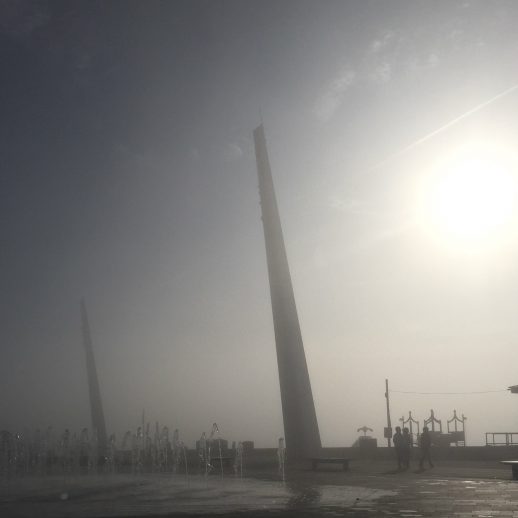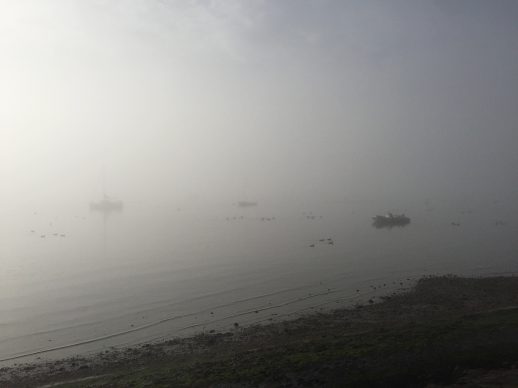Words and pictures: Jennifer Lucy Allan
Last week I cycled along the coast from Southend to Leigh-On-Sea through a dense fog. On this route I can usually see the Kent coast across the estuary. Sometimes I can make out the metal frames of the gas holders at the power station, and in summer there is an oblong field of yellow rapeseed on one sloping hill. Today that landscape has gone, the fog so dense that even the green hats marking the end of the beach groynes are obscured.
Elsewhere, planes are grounded, trains are on the slow down, and cars on the M25 are crawling through a swirling midday mist. This part of England – a basin around the Thames – is naturally prone to fog. Here in Essex, cars disappear as the road slopes up to Chalkwell and further on, the Crowstone obelisk that marks the end of the City of London’s jurisdiction is just a hazy grey shape out in the water. The world I inhabit has shrunk in line with how far I can see. I exist now in a bubble, not a landscape.
Fog brings a particular type of absence and separation from the physical world. In the dark we rarely experience such blackness as to be unable to make anything out. In fog, light remains, but depth and detail is gone. I strain to focus, but there is nothing for my eyes to fix upon. The dense grey-white is blank: uncanny and impenetrable.
Fog is formed by a temperature inversion, or when hot and cold air currents meet and condensation forms. Fog is not smog, which contains particulate matter like coal and dirt. Fog is not mist, although the technical dividing line between fog and mist is (if you permit me the terrible pun) a grey area and is a distinctly human-centric definition: the difference is only in how far you can see. There is more than one type of fog too. There’s radiation fog, advection fog, valley fog, hill fog. Upslope fog is where a fog of moist air is driven up the slopes of a mountain, but is almost indistinguishable from an orographic stratus (a hilltop cloud). There is such a thing as a fogbow: pale in colour, a half-halo of white mist.
London in the late 19th Century was beset with fog and deadly smogs. Clean air regulations hadn’t been implemented in line with the burning of coal as the city had expanded. Pea-soupers were a green-yellow, sometimes orange colour, dense and suffocating, thickened by the belching of dust and dirt into the air. The so-called ‘great fog’ of 1952 hung around a measly five days, which was nothing compared to one in 1879 that lasted four months. In one particularly grim scene, as recounted by Christine Corton in London Fog: The Biography, an entire herd of cattle was asphyxiated on the spot in Smithfield market because the air was too polluted to breathe.
Fog is a versatile literary device. In horror writing it is a quick fix: in Stephen King’s The Mist it brings monsters; James Herbert’s fog brings a madness that induces extreme and gratuitous violence; John Carpenter’s The Fog was one of the last great classic ghost stories of cinema: no aliens, no technology, no profound message about humanity, just leprosy-riddled pirate ghosts out for revenge.
Elsewhere in fiction it hid criminals and obscured the truth. It is an externally manifesting metaphor for the inner turmoil of central characters. A fog opens Bleak House, and Dracula arrived on the shores at Whitby in a strange fast-moving bank of sea fog: “White, wet clouds, which swept by in ghostly fashion, so dank and damp and cold that it needed but little effort of imagination to think that the spirits of those lost at sea were touching their living brethren with the clammy hands of death.”
In the closing days of 2016 I found an escape from the crushing news cycle, both in the fog that the last few weeks brought, and in my favourite type of fiction: apocalypse and dystopia. Unexpectedly, I found that the best antidote to feeling like civilisation was crumbling was reading 150-year old pulp fiction about how civilisation was crumbling.
In the late 19th Century, a handful of British writers thought the crumble would come because of the fogs, which made their way into pulpy, proto-disaster sci-fi, with London destroyed by the weather it brings upon itself.
In William Delisle Hay’s The Doom of the Great City; Being the Narrative of a Survivor, Written AD 1942, published in 1880, a grandfather recounts the degenerate state London had found itself in – “London was foul and rotten to the very core, and steeped in sin of every imaginable variety… pleasure-seeking being the only employment of the wealthy and governing class” – before a killer fog wipes everyone out in minutes. The protagonist, confused at why the postman hasn’t arrived at his commuter belt retreat, wanders the deathly streets alone.
J. Drew Gay’s The Mystery Of The Shroud from 1887 is terribly written, but starts on the premise of coal and iron ore being discovered under the south of England. London’s green spaces are all but removed to make way for boring and mining, “depriving the ever-increasing and now vastly growing metropolis the lungs which would have ensured it at least a certain supply of oxygen.” Unfortunately, the ecologically-minded story of urban apocalypse is just background for a sillier plot, whereby the deep fog brought by the mining is used as cover by an anarchist-socialist cult called the Order of the Shroud, who (confusingly) have a king and start kidnapping and murdering people in power in an attempt to force socialist policy into government. The message: look after green spaces or the socialists will take over.
Stumbling through the remains of the deathly London fog, the protagonist in Hay’s story feels a deep loneliness; in American playwright Eugene O’Neill’s plays fogs signal the final moments of life; St Augustine described the fog of lust, and of course, there is the fog of war.
In this still, quiet bubble along the estuary, I am not lonely or distressed, but content to feel disconnected from a familiar place; for the incoming demands and responsibilities of the new year to feel temporarily distant.
The closing weeks of 2016 were foggy, confused, suffocating. Pathetic fallacy says that when the fog shifts, all will become clear. But the idea that a change in the weather might bring some sort of clarity or redemption is a fallacy in itself. My mind circles back to O’Neill’s fogs. In his plays, fogs bring death, taking life as they clear. A fog hangs around the lifeboat until the crying baby has died in Fog; it drifts into the cabin as the character Yank breathes his last in Bound East For Cardiff.
But as my mind sticks on these dark thoughts, the mid-morning sun begins to heat the air and burn off the fog. I find myself reoriented in real life. I can see Kent again, the estuary, the ships (coming in and going out again). I am no longer elsewhere.
The fog lifted me temporarily from reality in one disorientating meteorological turn and I am reluctant for the weather to change. It was at once the state of the world and a welcome respite from it, my feelings echoed by Edmund in O’Neill’s Long Day’s Journey Into Night: “That’s what I wanted,” he says, “to be alone with myself in another world, where truth is untrue and life can hide from itself.”

